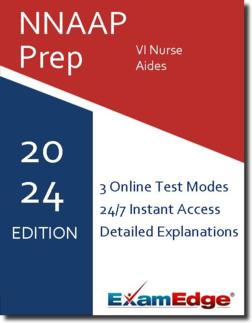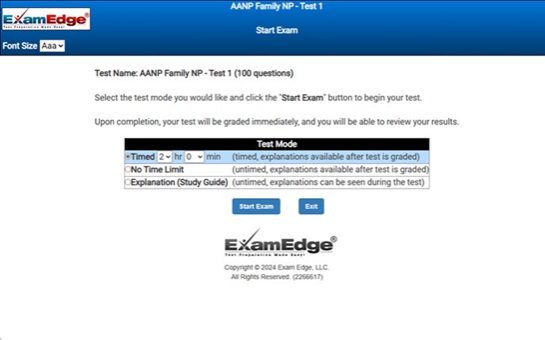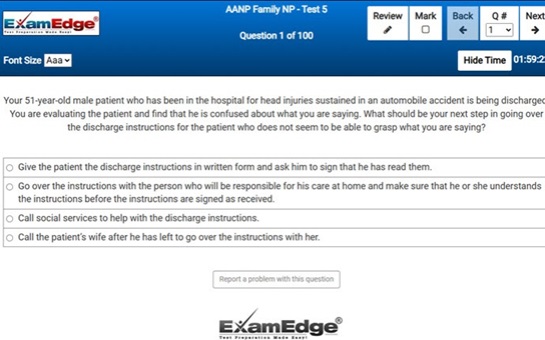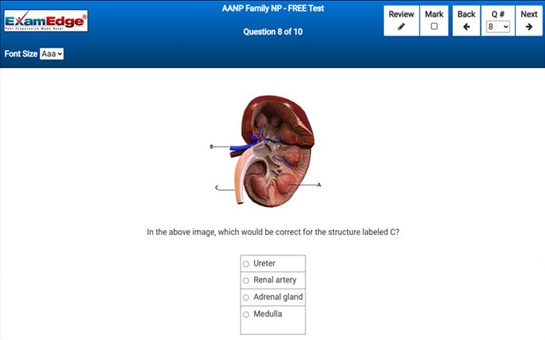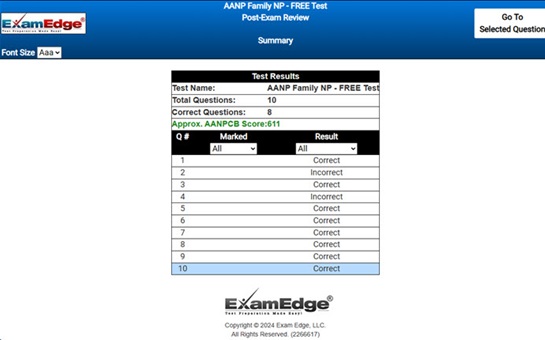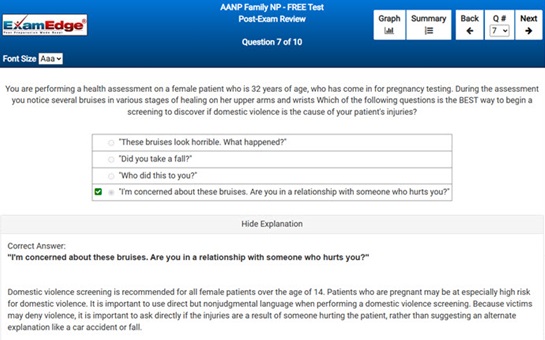NNAAP VI Nurse Aides Practice Tests & Test Prep by Exam Edge - FAQ
Get Instant Online Access Now!
** Sample images, content may not apply to your exam **
Looking for more information about the exam? Check out our NNAAP Virgin Islands Nurse Aides FAQs
Our practice tests are designed to help you master both the subject matter and the art of test-taking. Created to mimic the real exam, our practice tests feature:
- Instant access to your online practice tests - available 24/7
- Timed, untimed, and "study guide" modes
- Detailed explanations for each question
- 20 online practice exams - That's 1,400 unique questions
Review the information below and if you have any additional questions about NNAAP VI Nurse Aides practice tests that have not been answered here, Click her to contact Exam Edge Support.
Select Your Test Bundle
Excellent
NNAAP VI Nurse Aides () Shortcuts
General Exam Info
Exam Topics
Features
Study Plan Tips
Test Reviews
Why Exam Edge?
FAQ
Related Blogs
Take a FREE Test
Why should I use Exam Edge to prepare for the NNAAP Virgin Islands Nurse Aides Exam?
FAQ's for Exam Edge NNAAP Virgin Islands Nurse Aides practice tests
We have ten great reasons why Exam Edge is the #1 source on the internet when it comes to preparing for NNAAP Virgin Islands Nurse Aides test:
- Comprehensive content: Exam Edge's NNAAP Virgin Islands Nurse Aides practice tests are created specifically to prepare you for the real exam. All our NNAAP VI Nurse Aides practice test questions parallel the topics covered on the real test. The topics themselves are covered in the same proportions as the real test too, based on outlines provided by the National Council of State Boards of Nursing in their NNAAP VI Nurse Aides test guidelines.
- Realistic practice: Our NNAAP VI Nurse Aides practice exams are designed to help familiarize you with the real test. With the same time limits as the real exam, our practice tests enable you to practice your pacing and time management ahead of test day.
- Detailed explanations: As you complete your practice tests, we show you which questions you answered correctly and which ones you answered incorrectly, in addition to providing you with detailed step-by-step explanations for every single NNAAP Virgin Islands Nurse Aides practice exam question.
- Performance insights: After you complete a practice test, we provide you with your raw score (how many you answered correctly) and our estimate of the NNAAP VI Nurse Aides score you would have received if you had taken the real test.
- Ease of access: Because all our practice tests are web-based, there is no software to install. You can take NNAAP VI Nurse Aides practice exams on any device with access to the internet, at any time.
- Flexible use: If you must pause while taking one of our practice tests, you can continue right where you left off. When you continue the test, you will start exactly where you were, and with the same amount of time you had remaining.
- Thousands of unique questions: We offer 20 different online practice exams with 1,400 unique questions to help you prepare for your NNAAP Virgin Islands Nurse Aides!
- Low cost: The cost of ordering 5 practice tests is less than the cost of taking the real NNAAP VI Nurse Aides test. In other words, it would be less expensive to order 5 practice tests than to retake the real NNAAP Virgin Islands Nurse Aides exam!
- Our trusted reputation: As a fully accredited member of the Better Business Bureau, we uphold the highest level of business standards. You can rest assured that we maintain all of the BBB Standards for Trust.
- Additional support: If you need additional help, we offer specialized tutoring. Our tutors are trained to help prepare you for success on the NNAAP Virgin Islands Nurse Aides exam.
What score do I need to pass the NNAAP VI Nurse Aides Exam?
To pass the NNAAP Virgin Islands Nurse Aides test you need a score of 80.
The range of possible scores is 0 to 100.
How do I know the practice tests are reflective of the actual NNAAP Virgin Islands Nurse Aides?
At Exam Edge, we are proud to invest time and effort to make sure that our practice tests are as realistic as possible. Our practice tests help you prepare by replicating key qualities of the real test, including:
- The topics covered
- The level of difficulty
- The maximum time-limit
- The look and feel of navigating the exam
Do you offer practice tests for other National Council of State Boards of Nursing subjects?
Yes! We offer practice tests for 29 different exam subjects, and there are 670 unique exams utilizing 54700 practice exam questions. Every subject has a free sample practice test you can try too!
Canadian NCLEX
NCLEX Canadian Practical Nurse
Practice Tests
NCLEX Canadian Registered Nurse
Practice Tests
MACE
NCSBN MACE (MACE)
Practice Tests
MedAid
Certified Medication Aide//Assistant (MACE)
Practice Tests
NCLEX Pharmacology
NCLEX Pharmacology
Practice Tests
NCLEX-PN
Licensed Vocational Nurses
Practice Tests
NCLEX PN Diagnostic Readiness (Pre-Nclex-PN)
Practice Tests
NCLEX Practical Nurse
Practice Tests
NCLEX-RN
NCLEX RN Diagnostic Readiness (Pre-Nclex-RN)
Practice Tests
NCLEX Registered Nurse
Practice Tests
NCLEX Registered Nurse Psych and Mental Health
Practice Tests
NNAAP
NNAAP Alabama Nurse Aides
Practice Tests
NNAAP Alaska Nurse Aides
Practice Tests
NNAAP California Nurse Aides
Practice Tests
NNAAP Colorado Nurse Aides
Practice Tests
NNAAP District of Columbia Nurse Aides
Practice Tests
NNAAP Georgia Nurse Aides
Practice Tests
NNAAP Maryland Geriatric Nurse Aide
Practice Tests
NNAAP Minnesota Nurse Aides and Home Health Aides
Practice Tests
NNAAP Mississippi Nurse Aide
Practice Tests
NNAAP Nurse Aide
Practice Tests
NNAAP New Hampshire Nurse Aides
Practice Tests
NNAAP North Carolina Nurse Aide
Practice Tests
NNAAP Pennsylvania Nurse Aide
Practice Tests
NNAAP Rhode Island Nurse Aides
Practice Tests
NNAAP South Carolina Nurse Aide
Practice Tests
NNAAP Virgin Islands Nurse Aides
Practice Tests
NNAAP Virginia Nurse Aides
Practice Tests
NNAAP Washington Nurse Aides
Practice Tests
To order full-length tests, or take a sample test, for a different subject:
Click on ' Name on the Exam Name' You will be take to the orders page
How do I register for the real National Council of State Boards of Nursing?
For up-to-date information about registration for the National Council of State Boards of Nursing, refer to the National Council of State Boards of Nursing website.
What are the NCSBN exams?
Your next challenge in the pursuit of a career in nursing is the NCLEX. What exactly is this exam all about?
What is the National Council of State Boards of Nursing (NCSBN)
The National Council of State Boards of Nursing (NCSBN) is an independent not-for-profit organization through which boards of nursing act and counsel together on matters of common interest and concern affecting public health, safety and welfare, including the development of nursing licensure exams. The NCSBN is dedicated to developing psychometrically sound and legally defensible nurse licensure and certification exams consistent with current practice.
Requirements for eligibility to take the NCLEX and to get a license/registration authorization are determined by the board of nursing or regulatory body (BON/RB) of the institution where you intend to practice. You should first apply to the BON/RB. Once you receive the Authorization to Test, you can schedule your exam with Pearson VUE.
All NCLEX tests utilize Computerized Adaptive Testing (CAT). CAT is designed to target each candidate’s unique ability. Everyone begins with an item of relatively low difficulty. From that point forward, the candidate’s progression is dependent on his/her performance. The exam ends when the computer can determine with 95% confidence that a candidate’s performance is either above or below the passing standard, regardless of the number of items answered or the amount of testing time elapsed. There are no predetermined number of questions for the exams, but a maximum time for the NCLEX-RN is 6 hours and the NCLEX-PN is 5 hours. Multiple-choice, 4-option, text-based questions make up most of the exams. Items are written at an application/analysis level of difficulty. Some alternate formats are used and may include multiple-response, hot spot, fill-in-the-blank, and drag and drop (ordered response). Content for each NCSBN exam (Detailed Test Plans) is available online at www.ncsbn.org.
Official results will be sent to the candidate approximately 6 weeks after taking the exam. Most U.S. boards of nursing participate in quick results service which offers access to unofficial results 2 business days after taking the exam. A small fee is assessed if quick results is desired and available.
NNAAP Virgin Islands Nurse Aides - FAQ Sample Questions
|
|
|
|

